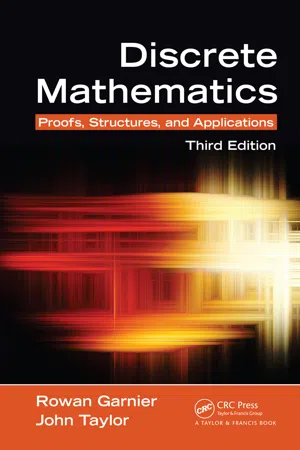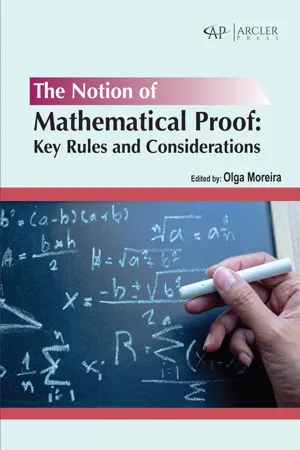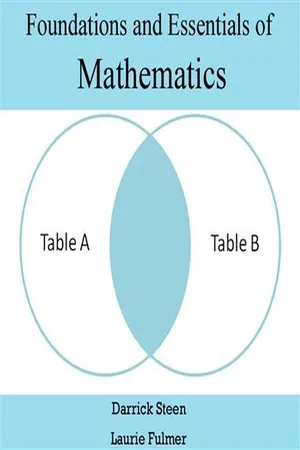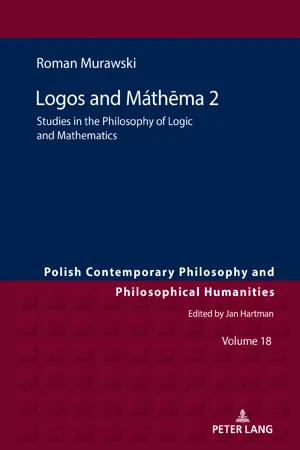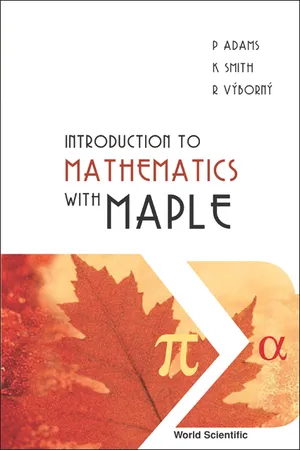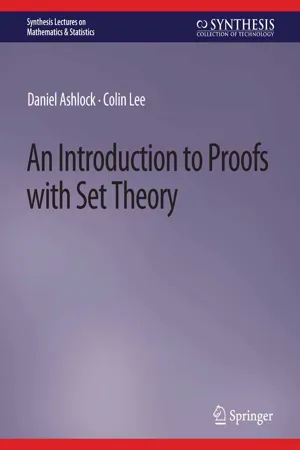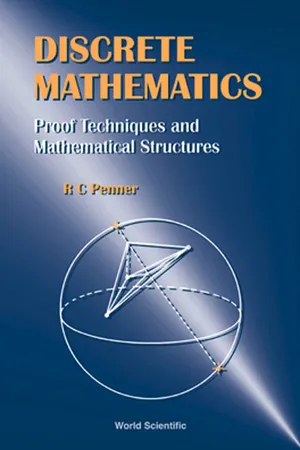Mathematics
Proof and Mathematical Induction
Proof and mathematical induction are fundamental concepts in mathematics. Proof involves demonstrating the truth of a statement using logical reasoning and previously established facts. Mathematical induction is a technique used to prove that a statement holds for all natural numbers by showing it holds for a base case and then demonstrating that if it holds for one case, it holds for the next.
Written by Perlego with AI-assistance
Related key terms
1 of 5
11 Key excerpts on "Proof and Mathematical Induction"
- eBook - PDF
Discrete Mathematics
Proofs, Structures and Applications, Third Edition
- Rowan Garnier, John Taylor(Authors)
- 2009(Publication Date)
- CRC Press(Publisher)
Chapter 2 Mathematical Proof 2.1 The Nature of Proof The discipline of mathematics is characterized by the concept of proof. In this chapter we consider the nature of mathematical proof, some of the different techniques of proof and how a proof should be constructed and written down. What do mathematicians mean by ‘proof’? The popular view of a mathematical proof is probably that of a sequence of steps, almost certainly written mainly in symbols, where each step follows logically from an earlier part of the proof and where the last line is the statement being proved. Associated with this image is probably the notion that a proof is the absolute and rigorous test of mathematical truth. Surprisingly perhaps, this is not quite the view of many mathematicians, although there is by no means unanimity of opinion amongst the mathematical professionals themselves. Many hold a more sociological view of the role of a proof. They see it as essentially an explanation and communication of ideas; a line of argument sufficient to convince a fellow mathematician of the validity of the particular result. As the great English mathematician Godfrey Hardy wrote: ‘Strictly speaking there is no such thing as mathematical proof; . . . [they are] rhetorical flourishes designed to affect psychology, . . . devices to stimulate the imagination of students.’ Which, then, is the ‘correct’ view of the nature and significance of the proof of a mathematical theorem? Probably the best answer is: both! The word ‘proof’ is used to cover a wide spectrum of styles. At one extreme we have very formal proofs which are rather like the logical arguments considered in chapter 1. Each step follows from the premises or a previous step by the laws of logic. Indeed, it is possible to write out such a proof using only symbols and no words but, needless 50 Axioms and Axiom Systems 51 to say, this is likely to be very difficult to follow. - Olga Moreira(Author)
- 2023(Publication Date)
- Arcler Press(Publisher)
There are two universally recognized proving methods namely deduction and induction (Kögce et al., 2010; Miyazaki, 2000). Deduction method of proof involves several methods encompassing direct proof, proof by contraposition, and proof by contradiction (Baki, 2008; Moralı et al., 2006). Deduction method in mathematics begins with a general statement or hypothesis and examines the possibilities to reach a specific logical conclusion (Morris, 2002). Induction method is generally used by 8th grade students or secondary school students because they have already learned to prove numerical or geometrical proposition (Miyazaki, 2000). These two methods are based on the types of reasoning used by someone in carrying out a proving process, of which each respectively refers to deductive reasoning and inductive reasoning. Deductive reasoning is unique because it is a process of deducing conclusions from known information (premise) based on formal logic rules, where the conclusions must come from information provided and do not need to validate them with experiments (Ayalon & Even, 2008). Whereas, Christou and Papageorgiou (2007) conveyed that inductive reasoning is a reasoning process from specific premises or observations to reach a general conclusion or an overall rule. Of those two, deductive reasoning, which is used in a deductive proof, is considered the preferred tool in many mathematical communities to verify mathematical statements and demonstrate universality. Therefore, Ayalon and Even (2008) argued that deductive reasoning is often used as a synonym for mathematical thinking. Deductive or Inductive? Prospective Teachers’ Preference of Proof ... 171 Knowledge of mathematical proof is considered as one essential component of subject matters (Shulman, 1986) in which mathematics teachers must acquire. Jones (1997) argued that teachers will have an extremely secured subject knowledge base of mathematical proof if they teach it accurately and confidently.- No longer available |Learn more
- (Author)
- 2014(Publication Date)
- Orange Apple(Publisher)
________________________ WORLD TECHNOLOGIES ________________________ Chapter- 5 Mathematical Proof Methods Mathematical induction An informal description of mathematical induction can be illustrated by reference to the sequential effect of falling dominoes. Mathematical induction is a method of mathematical proof typically used to establish that a given statement is true of all natural numbers (non-negative integers). It is done by proving that the first statement in the infinite sequence of statements is true, and then proving that if any one statement in the infinite sequence of statements is true, then so is the next one. ________________________ WORLD TECHNOLOGIES ________________________ The method can be extended to prove statements about more general well-founded structures, such as trees; this generalization, known as structural induction, is used in mathematical logic and computer science. Mathematical induction in this extended sense is closely related to recursion. Mathematical induction should not be misconstrued as a form of inductive reasoning, which is considered non-rigorous in mathematics. In fact, mathematical induction is a form of rigorous deductive reasoning. History In 370 BC, Plato's Parmenides may have contained an early example of an implicit inductive proof. The earliest implicit traces of mathematical induction can be found in Euclid's proof that the number of primes is infinite and in Bhaskara's cyclic method. An opposite iterated technique, counting down rather than up, is found in the Sorites paradox, where one argued that if 1,000,000 grains of sand formed a heap, and removing one grain from a heap left it a heap, then a single grain of sand (or even no grains) forms a heap. An implicit proof by mathematical induction for arithmetic sequences was introduced in the al-Fakhri written by al-Karaji around 1000 AD, who used it to prove the binomial theorem and properties of Pascal's triangle. - No longer available |Learn more
- (Author)
- 2014(Publication Date)
- Library Press(Publisher)
________________________ WORLD TECHNOLOGIES ________________________ Chapter 8 Mathematical Proof Methods Mathematical induction An informal description of mathematical induction can be illustrated by reference to the sequential effect of falling dominoes. Mathematical induction is a method of mathematical proof typically used to establish that a given statement is true of all natural numbers (non-negative integers). It is done by proving that the first statement in the infinite sequence of statements is true, and then proving that if any one statement in the infinite sequence of statements is true, then so is the next one. ________________________ WORLD TECHNOLOGIES ________________________ The method can be extended to prove statements about more general well-founded structures, such as trees; this generalization, known as structural induction, is used in mathematical logic and computer science. Mathematical induction in this extended sense is closely related to recursion. Mathematical induction should not be misconstrued as a form of inductive reasoning, which is considered non-rigorous in mathematics. In fact, mathematical induction is a form of rigorous deductive reasoning. History In 370 BC, Plato's Parmenides may have contained an early example of an implicit inductive proof. The earliest implicit traces of mathematical induction can be found in Euclid's proof that the number of primes is infinite and in Bhaskara's cyclic method. An opposite iterated technique, counting down rather than up, is found in the Sorites paradox, where one argued that if 1,000,000 grains of sand formed a heap, and removing one grain from a heap left it a heap, then a single grain of sand (or even no grains) forms a heap. An implicit proof by mathematical induction for arithmetic sequences was introduced in the al-Fakhri written by al-Karaji around 1000 AD, who used it to prove the binomial theorem and properties of Pascal's triangle. - eBook - PDF
A Discrete Transition to Advanced Mathematics
Second Edition
- Bettina Richmond, Thomas Richmond(Authors)
- 2023(Publication Date)
- American Mathematical Society(Publisher)
Chapter 2 Proofs All the measurements in the world are not the equivalent of a single theorem that produces a significant advance in our greatest of sciences. —Carl Friedrich Gauss (1777–1855) In questions of science, the authority of a thousand is not worth the humble reasoning of a single individual. —Galileo Galilei (1564–1642) 53 54 2. Proofs 2.1. Proof Techniques The familiar laws of algebra are not determined by opinion or fashion but are based upon solid mathematical proofs. A mathematical proof is a sequence of logical steps that unequivocally shows that a certain conclusion must follow from certain hypothe- ses. The sequence of logical implications which make up a proof must start with some statements or facts we assume. For example, to prove that a nondegenerate square has two diagonals, we must assume that the definition of diagonals of a nondegenerate square is known and furthermore, we must assume certain geometric axioms such as “there is a unique line through two distinct points”. In solving mathematical problems, including problems of proving a conjecture, there are three phases. First, one must understand the problem. This phase may include framing and posing the appropriate mathematical questions from the situation (“mod- eling” the problem). Interpreting the terminology and understanding definitions of all relevant terms will be required in this phase. Second, one must figure out how to solve the problem. For proofs, it may be helpful to consider some simple specific examples of the claim to gain insight into the general situation. Writing out the meanings of all given hypotheses and of the desired conclusion may assist in finding the appropri- ate logical links from the former to the latter. Finally, after determining the solution, the third phase is to carefully write the solution in a clear and correct style. For simple problems, these phases may overlap considerably. - eBook - PDF
Lógos and Máthma 2
Studies in the Philosophy of Logic and Mathematics
- Roman Murawski(Author)
- 2020(Publication Date)
- Peter Lang Group(Publisher)
Some Historical, Philosophical and Methodological Remarks on Proof in Mathematics Introduction Proofs play an important role in mathematics and its methodology (in the context of justification). They form the main method of justifying mathematical statements. Only statements that have been proved can be treated as belonging to the corpus of mathematical knowledge. Proofs are used to convince the readers of the truth of presented theorems. But what is in fact a proof? In mathematical research prac- tice, proof is a sequence of arguments that should show the truth of the claim. Of course, the particular arguments used in a proof depend on the situation, on the audience, on the type of a claim, etc. Hence a concept of a proof has in fact a cul- tural, psychological and historical character. In practice, mathematicians generally agree whether a given argumentation is or is not a proof. More difficult is the task to define a proof as such. Beside proofs used in the research practice there is a con- cept of a formal proof developed by logic. What are the relations between them? What roles do they play in mathematics? Problems of that type will be considered in the paper. We start by some historical remarks showing in what circumstance the idea of a proof (informal and formal) appeared. Next, the features and role played by informal proofs will be considered. The subject of the next section will be formal proofs and their relation to the con- cept of truth. In the closing section, some conclusions will be made and a thesis (similar to Church-Turing Thesis in the computation theory) formulated. Historical remarks The model of mathematics as a science, its paradigm functioning in fact till to- day, was formulated and developed in the ancient Greece about th century B.C. - eBook - PDF
- P Adams, K Smith;R V??born??;;(Authors)
- 2004(Publication Date)
- WSPC(Publisher)
Chapter 5 Mat hernat ical Induction In this chapter we study proof by induction and prove some im- portant inequalities, particularly the arithmetic-geometric mean inequality. In order to employ induction for defining new objects we prove the so called recursion theorems. Basic properties of pow- ers with rational exponents are also established in this chapter. 5.1 Inductive reasoning The process of deriving general conclusions from particular facts is called induction. It is often used in the natural sciences. For example, an ornithol- ogist watches birds of a certain species and then draws conclusions about the behaviour of all members of that species. General laws of motion were discovered from the motion of planets in the solar system. The following example shows that we encounter inductive reasoning also in mathematics. Example 5.1 numbers: Let us consider the numbers n5 - n for the first few natural n n5-n 1 0 2 30 3 240 4 1020 5 3120 6 7770 7 16800 It seems likely that for every n E N the number n5 - n is a multiple of 10. 129 130 Introduction to Mathematics with Maple The reasoning in the above example does not give us the feeling of cast- iron certainty which mathematical arguments usually have. It may not be true for n = 8, though you can easily check that it is. Even if you have used a computer to check the first billion natural numbers, that does not prove that it is true for all natural numbers. Indeed, basing arguments on a finite number of examples is an uncertain procedure, and it can lead to serious mistakes, as we shall shortly see in Example 5.2. In everyday life, and in the natural sciences, our conclusions are subject to further observations and experiments (devised to check the conclusions). In mathematics this additional check is missing, and there is yet another important difference. In Example 5.1 we observed a few particular cases, but we made conclusions about the validity of the formula for infinitely many cases. - eBook - PDF
- Daniel Ashlock, Colin Lee(Authors)
- 2022(Publication Date)
- Springer(Publisher)
39 C H A P T E R 4 Mathematical Proofs 4.1 SOME BACKGROUND In the previous chapter we have seen what a valid argument is, and examined rules of inference. This chapter is concerned with mathematical proofs. Mathematical proofs are logical arguments that demonstrate a mathematical claim. There are several major categories of proofs. This chapter introduces some of the most important and commonly used ones. We shall start with a quick example proof. Example 4.1 Claim: There are an infinite number of positive whole numbers. Proof: If there are not an infinite number of positive whole numbers then there must be a finite number n of whole numbers. Examine the list 1; 2; 3; : : : ; n of positive whole numbers. The list contains n whole numbers and so must therefore contain all positive whole numbers. We note, however, that the number n C 1 fails to appear on the list. This means the list is not complete. We have thus demonstrated that any finite list of integers is incomplete and deduce the list of all positive whole numbers is infinite. This is an informal proof, but it is a proof. In particular, it states a claim which will be proven then proceeds to demonstrate, by means of careful, precise language and deduction that the claim is true. The proof is an example of a proof technique called “proof by contradiction,” where the opposite of what we are attempting to prove is assumed and used to derive a logical contradiction. Unlike a valid argument form most proofs do not actually explicitly state every single assump- tion (premise) that is being used. For example, it is not explicitly stated that the two categories “finite” and “infinite” are mutually exclusive (no list or collection can be both finite and infinite) and exhaustive (there is no third option), nor is it stated that for any whole number n one may always construct a larger whole number n C 1. - eBook - PDF
- John Taylor, Rowan Garnier(Authors)
- 2016(Publication Date)
- Chapman and Hall/CRC(Publisher)
Chapter 8 Mathematical Induction 8.1 Introduction In this chapter we consider in some detail one particular method of proof, called proof by mathematical induction, which may be used to prove state-ments about the natural numbers or positive integers. In other words, the method will apply to the proofs of propositions of the form ∀ n • P ( n ) where the universe for n is the set of natural numbers N or the set of positive inte-gers Z + . The following are examples of the kinds of results that we may prove using the method of mathematical induction. 1. The sum of the first n positive integers is 1 2 n ( n + 1); symbolically, for all n ∈ Z + , 1 + 2 + 3 + · · · + n = 1 2 n ( n + 1) . 2. For every n ∈ N , the expression 5 n + 3 is divisible by 4. 3. For all finite sets A , if A has cardinality n , then its power set P ( A ) has cardinality 2 n . The first of these is clearly of the form ∀ n ∈ Z + • P ( n ) and the second is of the form ∀ n ∈ N • P ( n ). However, the third statement is not obviously of one of these two forms. Note that, to say that a set A is finite means it has cardinality | A | = n where n is some natural number. This means we could rephrase the third statement as ‘for all n ∈ N , if A is a set with cardinality | A | = n , then its power set has cardinality | P ( A ) | = 2 n ’ and this is of the form ∀ n ∈ N • P ( n ). This is not unusual. Sometimes a statement is not obviously one about N or Z + , but is more naturally about some other mathematical object such as a set, function, group, graph or whatever. But, by rethinking the statement, it may be rephrased to be one about say the positive integers; the advantage of this is that it brings into play the possibility of using the powerful method of mathematical induction. Despite its name, any proof by mathematical induction uses deductive rea-soning, which is the basis of all mathematical proofs; it does not rely on the kind of inductive reasoning described in section 1.3. 303 - eBook - PDF
Discrete Mathematics
Mathematical Reasoning and Proof with Puzzles, Patterns, and Games
- Douglas E. Ensley, J. Winston Crawley(Authors)
- 2011(Publication Date)
- Wiley(Publisher)
2 A Primer of Mathematical Writing In the previous chapter, we looked at the nature of deductive reasoning as it relates to everyday experience, and we studied the logical structure of math- ematical statements, discussing at length what it means for a statement to be true or false. In this chapter, we will discuss the properties of some common mathematical objects and how to present a mathematical proof about these properties to others. The subject of our first efforts will be properties of integers, simply be- cause integers are the mathematical objects most familiar to us. We will use these familiar objects to build our skills in writing proofs of mathematical statements. In the third and fourth sections, we will consider the proof tech- nique known as mathematical induction, arguably the most important proof structure in discrete mathematics. In the fifth section, we will study a tech- nique called “proof by contradiction,” which applies indirect reasoning in an argument. Finally, in the last two sections we will apply the skills we have developed to explore some problems of interest to the typical student of mathematics, computer science, or education. It is often the case that the abstract nature of mathematics makes mathe- matical proofs seem more mysterious than other forms of argument. For this reason, we will make every attempt to separate the logic of our arguments from the abstract nature of the subject matter. We will take time to build an understanding of the mathematical objects and properties before attempting proofs. If we are patient enough, the logical structure of your mathematical writing will seem as natural as an argument with your sister. 81 82 Chapter 2 / A Primer of Mathematical Writing 2.1 Mathematical Writing Mathematicians today rely on the notion of symbolic logic to serve as the foundation of the system of reasoning that they bring to bear on the solution of problems. - eBook - PDF
Discrete Mathematics
Proof Techniques and Mathematical Structures
- R C Penner(Author)
- 1999(Publication Date)
- WSPC(Publisher)
24 Chapter 1 Proof Techniques (*) Part B METHODS OF PROOF It is not a vast oversimplification to assert that much of mathematics boils down to proving that propositions of the form P => Q are true, where P and Q are particular propositions. From the very definition, P =£» Q is proved to be true if whenever P is true, Q is also true, for P => Q is automatically true whenever P is false. Thus, to prove that P => Q in practice, we may assume that P is true and try to conclude that Q is true. This second part of Chapter 1 is dedicated to various methods of proving im-plications. Each subsection contains a discussion of one or several such methods, and each method is associated with a certain tautology just as our proof above that [I am a duck] =>• [I waddle] relied on tautology (*) in §A.4. Each subsection therefore begins with a short discussion of the relevant tautological propositions! forms and then presents numerous examples of the associated proof techniques. In these various examples, we shall prove that P => Q is true for particular proposi-tions P and Q. In our examples, P and Q will often involve mathematical objects such as triangles, natural numbers, and so on, but the reader should keep in mind that our intent is to exhibit logical techniques many of which are already familiar from everyday life. Exercises on the various methods of proof taken together are given at the end of the chapter. It is probably best in a normal course to just survey in lectures and discussions the material presented in this second half of Chapter 1 and to relegate its more comprehensive study to a serious reading assignment. There is no real loss of continuity in skipping directly to Chapter 2, but the reader who is untiring and carefully studies the examples here will surely profit in insight there. As mentioned in the preface, we do not usually assign problems on this material at this point, but we include a comprehensive section of final exercises for completeness.
Index pages curate the most relevant extracts from our library of academic textbooks. They’ve been created using an in-house natural language model (NLM), each adding context and meaning to key research topics.
